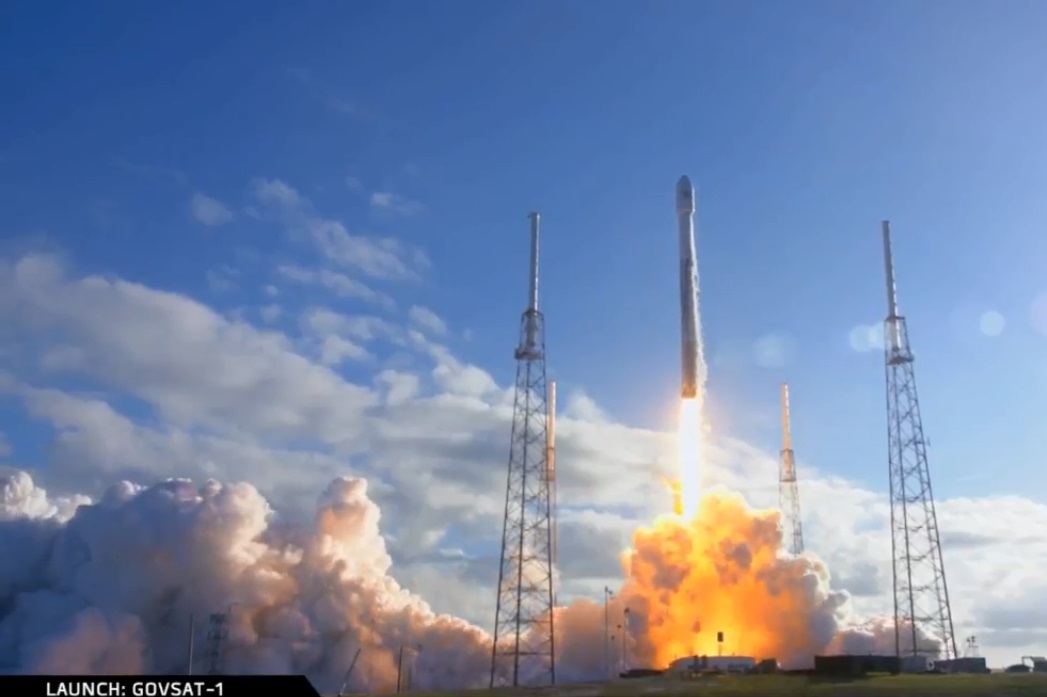SpaceX Launches Satellite Into Orbit on a Used Falcon 9 Rocket
Today (Jan. 31), yet another pre-flown SpaceX rocket took to the skies, successfully delivering a communications satellite to orbit.
The two-stage Falcon 9 booster lifted off at 4:25 p.m. EST (2125 GMT) from Cape Canaveral Air Force Station, hauling the GovSat-1 spacecraft aloft. The launch was originally scheduled for Tuesday (Jan. 30), but SpaceX pushed it back a day to replace a sensor in the Falcon 9's upper stage.
The rocket's first stage had flown once before, helping launch the NROL-76 spy satellite for the U.S. National Reconnaissance Office back in May 2017. [Photos: SpaceX's 1st Secret US Military Satellite Launch (& Landing)]
Following last year's launch, the booster came down to Earth for a pinpoint landing, but there was no touchdown attempt today. This Falcon 9 first stage is part of a booster set that was designed to fly just twice, according to Florida Today.
New versions of the Falcon 9 first stage, which should begin flying soon, will be capable of launching 10 or more times, SpaceX founder and CEO Elon Musk has said.

To date, SpaceX has landed 21 Falcon 9 first stages, and it has now re-flown boosters six times, all of those attempts successful. Such work is part of the company's effort to develop fully and rapidly reusable rockets and spaceships, technology that will slash the cost of spaceflight, Musk has said. (The Falcon 9's second stage is not reusable at the moment, though Musk has said that he'd also like to land this piece of hardware eventually.)
GovSat-1 is a joint mission involving the government of Luxembourg and commercial satellite operator SES, which is based in the small European country. The 9,325-lb. (4,230 kilograms) satellite, which was built by U.S. aerospace company Orbital ATK, is headed for geostationary orbit, about 22,300 miles (36,000 kilometers) above Earth.
Get the Space.com Newsletter
Breaking space news, the latest updates on rocket launches, skywatching events and more!
"GovSat-1 was designed for dual use to support both defense and civil-security applications, including mobile and fixed communications," SES representatives wrote in a description of the satellite.
From its orbital perch, the satellite "will be ideally located to support communications within Europe, the Middle East and Africa, and to provide highly reliable and flexible interconnectivity for defense and institutional applications within its coverage area," the representatives added. "GovSat-1 will also enable operations over the Atlantic and Indian oceans."
The satellite's design lifetime is 15 years.
SpaceX's next launch is one that spaceflight fans have been looking forward to for a long time: the first-ever flight of the company's huge new Falcon Heavy rocket. The Heavy is scheduled to lift off from Cape Canaveral on Feb. 6, on a demo flight that will try to sling a cherry-red Tesla Roadster — Musk also runs Tesla — into orbit around the sun.
Follow Mike Wall on Twitter @michaeldwall and Google+. Follow us @Spacedotcom, Facebook or Google+. Originally published on Space.com.
Join our Space Forums to keep talking space on the latest missions, night sky and more! And if you have a news tip, correction or comment, let us know at: community@space.com.

Michael Wall is a Senior Space Writer with Space.com and joined the team in 2010. He primarily covers exoplanets, spaceflight and military space, but has been known to dabble in the space art beat. His book about the search for alien life, "Out There," was published on Nov. 13, 2018. Before becoming a science writer, Michael worked as a herpetologist and wildlife biologist. He has a Ph.D. in evolutionary biology from the University of Sydney, Australia, a bachelor's degree from the University of Arizona, and a graduate certificate in science writing from the University of California, Santa Cruz. To find out what his latest project is, you can follow Michael on Twitter.









